2011 Year in Review: UCSF Advances Research from Bench to Bedside
UCSF has continually ranked among the top recipients of competitively awarded research funds from the National Institutes of Health (NIH). UCSF is also distinguished among universities for reporting discoveries that are most often referenced by groundbreaking researchers internationally.
Here is just a sampling from 2011 of research advances at UCSF that have helped to keep a steady stream flowing through the pipeline that leads from research discovery to better healthcare — including greater patient safety, more efficient healthcare delivery, and improved outcomes for patients.
Clinical Research and Public Health Advances
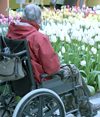
Heart Failure Hospital Stays Are Reduced
Heart Failure patients spent less time in the hospitals, thanks to a program designed to identify ways for hospitals to improve patients' transitions to their homes. UCSF Medical Center reduced hospital readmissions for older heart failure patients by 30 percent. UCSF’s Heart Failure Program reduced both 30-day and 90-day readmissions for patients 65 and older through the program, launched in 2008 with a $575,000 grant from the Gordon and Betty Moore Foundation.The program has cut Medicare billing by at least $1 million annually at UCSF, while freeing up hospital beds for other patients.
Fetal Surgery Improves Spina Bifida Outcomes

The UCSF Fetal Treatment Center showed that surgery before birth can improve results in babies with a type of spina bifida in which the bones of the spine do not fully form. Babies who undergo a procedure to repair spina bifida in the womb experience healthier development and fewer neurologic complications than babies who have corrective surgery after birth, according to findings from the major multicenter trial led by UCSF researchers. The study was the first to systematically evaluate the best treatment for myelomeningocele, the most serious form of spina bifida. The clinical investigators stopped the eight-year trial early, because results were so positive. The researchers found that prenatal surgery greatly reduces the need to divert fluid away from the brain, improves mental development and motor function, and increases the likelihood that a child will one day walk unassisted.
UCSF Marks 30 Years of HIV/AIDS Leadership

Thirty years after the first cases of AIDS were reported, UCSF and San Francisco General Hospital (SFGH) continue to set the standard for translating research discoveries into better HIV/AIDS treatment, and these medical centers remain top-ranked for HIV care by U.S. News & World Report. UCSF physicians also are leading major international efforts to combat the disease worldwide. UCSF researchers are conducting trailblazing research showing the effectiveness of treatment at diagnosis for preventing the spread of HIV infection, the role of HIV infection in aging and implications for patient care, and the potential of treatments that could lead to an HIV cure.
Multiple Sclerosis Treatments Hold Promise
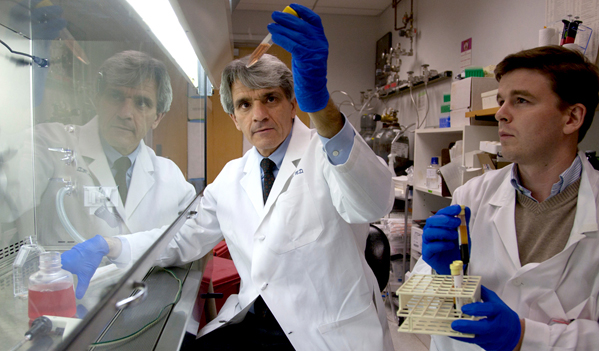
Stephen Hauser, MD, chair of the Department of Neurology, works with Pierre-Antoine Gourraud, PhD, in the lab at UCSF.
UCSF researchers are advancing medical understanding of multiple sclerosis (MS) and the ability to treat it. A UCSF group led by Stephen Hauser, MD, chair of the Department of Neurology, announced several important discoveries this year, including a major clinical trial in which Hauser and colleagues showed that a new monoclonal antibody drug lessens brain inflammation in multiple sclerosis. In another study UCSF researchers found an association between low levels of vitamin D and multiple sclerosis risk in African Americans.
UCSF Researchers Help to Shrink Global Range of Malaria
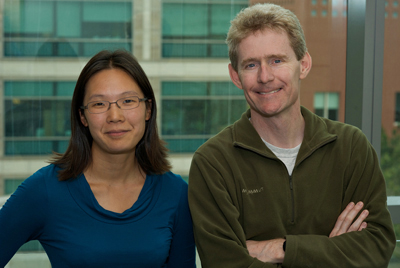
Ellen Yeh, MD, PhD, a pathologist from Stanford Medical School, and UCSF biochemist Joseph DeRisi, PhD, have made a fundamental discovery about malaria parasites that gives new hope for future drugs and vaccines.
With powerful new drug combinations, a promising vaccine on the horizon, and effective measures like insecticide-treated bed nets, the world is poised to dramatically shrink the range of malaria across the globe in coming years. Programs at UCSF led Sir Richard Feachem are contributing to this effort in major ways. This work got a boost when Jaime Sepulveda joined UCSF as the new executive director of Global Health Sciences. A major paper from Joe DeRisi's group revealed some of the malaria parasite’s inner workings and raised hope for the development of new drugs and vaccines.
Basic Biomedical Research and Population Sciences
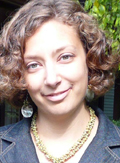
Lauren Weiss, PhD, assistant professor of psychiatry
Autism Studies Shed Light on Role of Genes and Environment
Genes and environment both contribute to autism, but the largest and most rigorous autism study to date on twins showed that heredity in autism is overshadowed by environmental factors, possibly in the fetal environment. The study, which started with 2,312 twins in which at least one member was affected by autism, found that the children’s environment represents more than half of the susceptibility — 55 percent in the most severe form of autism and 58 percent in the broad spectrum of the disorder. The collaborative work tapped expertise from the UCSF Institute for Human Genetics and Stanford University — which jointly led the research — as well as from Kaiser Permanente, UC Davis, the Autism Genetic Research Exchange and the California Department of Public Health.
In other UCSF autism studies, Lauren Weiss, PhD, winner of a prestigious NIH Director’s New Innovator Award, is working to identify a network of genes — many previously unsuspected — that may be contributing to autism by lowering levels of a protein called semaphorin 5A. The protein already is known to play a role in linking nerves together during development.
Asthma Research Offers Surprises on Tobacco and Genetic Links
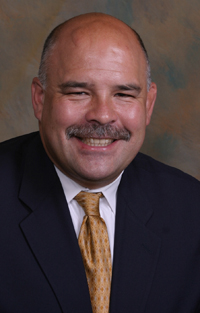
Esteban Burchard, MD, MPH
Asthma has long been known to have both genetic and environmental causes, but two new studies this year led by Esteban Burchard, MD, a geneticist in the UCSF School of Pharmacy, have shined a light on just how important those elements are — and what environment is most dangerous for children.
In August, Burchard published a paper in Pediatrics that showed that prenatal exposure to cigarette smoke far outweighed the role of exposure to cigarettes after birth. In fact, children with severe asthma were 3.6 times more likely to have been exposed to tobacco smoking before birth than children with a mild form of the disease, even if they were not exposed at all during childhood. The research could have a direct impact on public health campaigns, as more than one in seven pregnant women smoke in the United States.
Burchard also led a collaborative research project on genetic variations associated with increased asthma risk in people of African ancestry. The research, which appeared in Nature Genetics, used a new DNA analysis spanning the entire genomes of thousands of asthma sufferers. The project identified new genetic variations in African ancestry that are linked to the disease and also confirmed an asthma association for four other common gene variations that came to light late last year in a large study of Europeans. The new study demonstrates that these genes appear to affect risk in other populations, as well.
Stem Cell Research Progresses
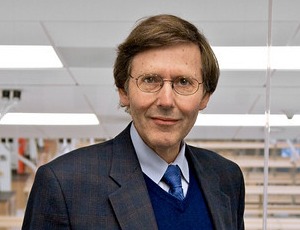
Arnold Kriegstein, MD, PhD
Laboratory researchers on the UCSF faculty continue to make seminal contributions to the field of stem cell research. New brain stem-cell discoveries by Arnold Kriegstein, MD, PhD, director of the Eli and Edythe Broad Center of Regeneration Medicine and Stem Cell Research at UCSF, are shedding light on brain development and human evolution. UCSF researcher Sheng Ding, PhD, from the Gladstone Institutes, developed safer methods to transform embryonic stem cells into large numbers of brain cells with multiple uses, and he also succeeded in transforming adult skin cells into so-called neural stem cells — cells that are just beginning to become brain cells.
In some cases — some cancers, for instance — stem cells act abnormally. A team led by UCSF’s Emmanuelle Passegué, PhD, has uncovered the steps taken by stem cells to drive the development of blood cancer. Using a mouse model of human chronic myelogenous leukemia (CML), her group discovered an essential role for the inflammatory factor IL-6, which may be a potential target for controlling the development of CML.
Stem cell studies in humans have begun, as well. At UCSF Benioff Children’s Hospital, David Rowitch, MD, PhD, chief of Neonatology, is leading the first US neural stem cell trial to treat a disease caused by lack of myelin, an insulating sheath for nerves.
UCSF also launched a collaboration with GE Healthcare this year to tackle a major obstacle in adult stem cell therapies for blood-related diseases: generating large enough quantities of the progenitor cells from umbilical cord blood. The partnership, which includes the UCSF School of Pharmacy’s Small Molecule Discovery Center and the Adult Blood and Marrow Transplant Laboratory, will use ultra-fast, robotic technology like that used in pharmaceutical companies to screen about 120,000 chemicals, in search of compounds to trigger the expansion of the stem and progenitor cells.
Gene Therapy Research Is Reinvigorated

Y. W. Kan, MD, a pioneer of modern genetics, is now leading a new $6.7-million, five-year research project to find a cure for sickle cell anemia and other life-threatening genetic disorders.
A cure for sickle cell anemia and other life-threatening genetic disorders that arise in the blood is the goal of a new $6.7-million, five-year, pre-clinical research project headed by UCSF scientist Y.W. Kan, MD, a pioneer of modern genetics and the diagnosis of genetic diseases before birth. The study combines gene therapy and stem cell therapy. The researchers aim to develop “induced pluripotent” stem cells from the blood of patients with sickle cell disease, to correct the sickle cell defect using novel gene-therapy techniques, and then to coax the corrected stem cells to become an ample supply of “hematopoietic” stem cells that can regenerate the entire blood system.
This year the promise of gene therapy to treat inborn blood diseases was highlighted by success in a clinical trial to correct a genetic defect in hemophilia B, led by researchers at St. Jude Children's Research Hospital in Memphis and University College London in the United Kingdom. After a single treatment, four of six patients were able to forego what normally is a lifelong treatment — injections with a blood-clotting protein.
Genomics Research Gets Boost from UCSF and Kaiser Permanente
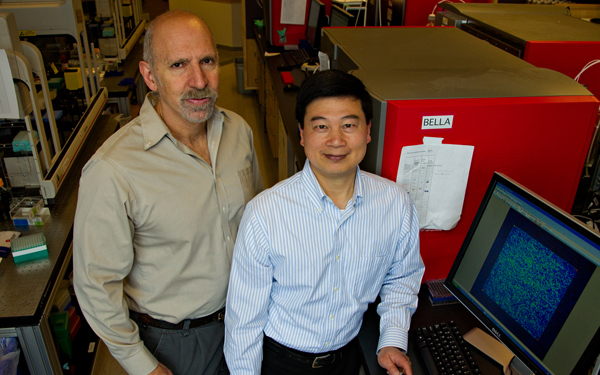
Neil Risch, PhD, co-director of the Research Program on Genes, Environment and Health and director of the UCSF Institute for Human Genetics, stands with Pui-Yan Kwok, MD, PhD, a UCSF professor who led the single nucleotide genotyping work at UCSF.
In the nation’s largest and most diverse genomics project, researchers reached a major milestone this year, performing whole-genome genotyping of the DNA of 100,000 Kaiser Permanente members who agreed to take part in the study. The UCSF arm of the project, led by Neil Risch, PhD, director of the UCSF Institute for Human Genetics, and Pui-Yan Kwok, MD, PhD, also worked with researchers in Elizabeth Blackburn’s laboratory to analyze the length of the protective tips on the chromosomes in each sample. These structures, called telomeres, are beginning to be linked to chronic disease and aging. The genotyping and telomere data ultimately will be linked with patients’ health records to accelerate research into the connections between genetics, environment and health.
HIV Research Maps Hundreds of New Viral-Human Protein Interactions
Every apparent physical interaction HIV makes with components of the human cells it infects was mapped by an international team of scientists, drawing on key expertise in the UCSF schools of Medicine and Pharmacy. The analysis found 497 connections that HIV’s handful of proteins makes with hundreds of human proteins and other components inside human cells — work that may reveal new ways to design future HIV/AIDS drugs. Explored in the journal Nature, the survey was published back-to-back with a companion paper that investigated one such connection in detail, involving an HIV protein called Vif.
The collaboration was led by Nevan Krogan, PhD, a UCSF associate professor of Cellular and Molecular Pharmacology at UCSF who is also affiliated with the California Institute for Quantitative Biosciences (QB3) and the J. David Gladstone Institutes. The work relied heavily on UCSF’s historic and current expertise in HIV protein research, mass spectrometry and gene expression, as well as computational work in biological networks. Several of the researchers are also associated with the Host Pathogen Circuitry Center and HIV Accessory and Regulatory Complexes Center (HARC) at UCSF.
Fat Studies in Animals Can Shed Light on Human Ills
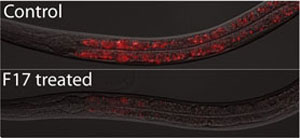
The UCSF team identifed chemical compounds that reduced the accumulation of fat (highlighted in red) in worms, as seen in the treated worms.
A large majority of Americans are overweight, and type 2 diabetes is at epidemic levels — so it’s fitting that UCSF boasts many researchers who are advancing scientific understanding of fat, obesity and health. This year Kaveh Ashrafi, PhD, uncovered a handful of chemical compounds that regulate fat storage in worms. Mary Dallman, PhD, and Elissa Epel, PhD, have begun human studies to extend Dallman’s pioneering research findings, in which she studied rats to demonstrate that chronic stress affects cortisol secretion and triggers fat and sweet consumption, resulting in the accumulation of deep abdominal fat. Similarly, humans may be using comfort food to “self medicate” in response to stress.
UCSF researchers also are advancing our understanding of a type of fat known as brown fat, generating ideas for new weight loss strategies. Researcher Shingo Kajimura, PhD, a recent arrival to UCSF, previously showed that a pair of proteins can be used to convert common fibroblast cells from the skin into calorie-burning brown fat in animals, and now he is manipulating proteins to spur fat metabolism. Most recently, Ajay Chawla, MD, PhD, discovered that cells of the immune system can trigger greater fat burning.
RNA Research Alters Views of Gene Activation, Protein Production and Development
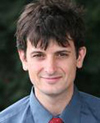
Robert Blelloch, MD, PhD
DNA is, of course, a starring molecule on the research stage, the one that forms the double-stranded helix of genes. But largely out of public view, a related type of molecule — single-stranded RNA — is gaining increasing attention and respect from scientists. This rarely celebrated sibling of DNA was long thought to serve merely as a messenger and translator to ease the production of proteins from already activated genes. But Nobel-Prize-winning research has revealed that small fragments of RNA called micro-RNAs also help determine which proteins will be made from DNA’s genetic blueprints. In this still-young and fast moving field, UCSF’s Robert Blelloch, MD, PhD, winner of the 2011 Outstanding Young Investigator Award from the International Society for Stem Cell Research, has been looking at microRNAs as a potential tool to systematically dissect the molecular pathways that govern the form, function and fate of cells during development.

Maria Barna, PhD
UCSF’s Maria Barna, PhD, has now discovered another means of controlling protein production, one that again involves RNA. Machines within cells translate genetic messages from RNA to make all the cell’s proteins. These machines — called ribosomes — are themselves made of RNA and proteins, and were once thought to act identically, in every cell, on every RNA message, to make all the proteins the cell needs. But Barna has discovered that ribosomal proteins also play a previously unsuspected role in varying the production of specific proteins during the translation of RNA messages at specific times and places within a mammal. Ribosomal proteins thereby play a key role in helping to shape development.
